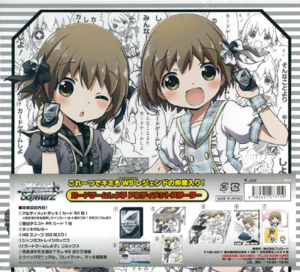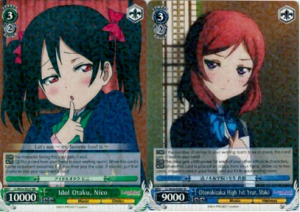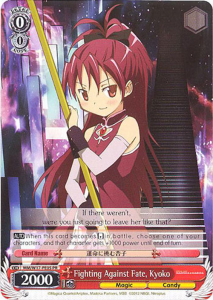A card game on The Daily SPUF???

This time I’m going to be writing about something a little different. Instead of a game you can play on your phone or computer, this game requires you to use physical items. Moreover, it requires you to *gasp* go meet other real life people.
Weiss Schwarz is a card game made by Bushiroad. Unlike what the name might imply, it is a Japanese card game, not a German one. The game is divided into two sides, Weiss and Schwarz. The Weiss side is filled with the ‘cute’ series, while the Schwarz side is filled with the ‘cool’ series. You can check which side a series is in based on the colour of the feathers at the bottom of each card in a series. Before I go any further, I should clarify that this card game is based on different anime (with some visual novels getting their own series), so if you hate that kind of stuff this game isn’t for you.

Assuming the above statement didn’t scare you away, Weiss Schwarz is a relatively simple game. While some sets are stronger than others, most people will choose which series to play based on their favourite anime, not based on strength. Seeing as a lot of the cards are similar, if not identical, this isn’t too surprising. On the plus side, this makes balancing the cards a lot easier, as there isn’t hundreds of different effects to have to consider.
One important thing to consider when playing is what standard you’re going to play, as well as what language. There are different standards, just like there are different competitive standards in TF2. There’s neo-standard where you cannot mix series, and there’s other standards where you can mix different series. I only play neo-standard, so that’s what I’m going to write about for this. The other consideration is language, which changes what you can play. There are much more sets available in Japanese, with new sets being released at a faster rate than in English. The downside to Japanese however, is that it has a banlist. English generally fixes overpowered cards, which means you don’t have to worry about any banlists (important if you want to play Kantai Collection).
Let’s start off with the basics. There are four colours: red, blue, green, and yellow. Each card is also divided into different levels: 0, 1, 2, and 3. There are also character cards, backups, events, and climax cards. Backups can either be character backups or event backups, which changes how they work slightly.
Let’s start off with the levels. Each player has a level zone and a clock zone. You start at level zero, and level up until someone reaches level 4. Whoever reaches level 4 first loses. Each player also has a clock that holds 6 cards. When you get 7 cards in your clock, you must choose a card in it (out of the seven) to place into your level zone, with the rest going to the waiting room (graveyard basically). Unlike a lot of other games, running out of cards in your deck does not mean you lose. You just refresh (reshuffle) your waiting room into your now empty deck, and place the top card into your clock as refresh damage. In order to play cards of different levels, your level must be equal to or higher than the cards level. If I want to play my all powerful level 3’s, I must be level 3 myself. This provides an interesting dynamic, where the closer you are to dying, the more powerful cards you can play. This can lead to some interesting decisions which I will get to later.

The other important part is the colour of each card. In order to play a card that is level 1 or higher, you must have a card of the same colour in your clock or level zone. Playing a climax card also requires you to have a card with the same colour in your clock or level zone. This means that the card you choose to level up with is an important decision, as it can affect what you can play. Generally, running 2 colours is the recommended strategy, although you can run a mono-colour deck, or even a deck with 3 or 4 colours. However many colours you run is highly dependent on the series you’re playing with, as well as the build you choose from your series.
On to the deck building. Each deck must contain 50 cards, nor more and no less. On top of this, each deck has a maximum of 8 climaxes in it. Climax cards are very important, as these cancel the damage you take. Climax are used for their effects such as boosting power, increasing soul damage, or drawing a card. Climax card are also the only ones with special triggers. Character cards will form the majority of your deck, being used to kill the enemy. Character cards have a level, as well as a stock cost. They also have a base soul damage, which indicates how much soul damage they swing for. Event cards often have very different effects from the other two. Events have abilities that can range from healing you, letting you search a character from your deck, or just boosting the power of a specific card. Backups are as the name suggests, used to back up a character that is attacked. The difference is that character backups are not dependent on your level zone or clock having a certain colour in it, while event backups require the correct colour. Event backups also generally can have different effects than just boosting power.

With all this talk on soul damage and power, it probably helps to clarify this. The damage a character deals is not dependent on its power, nor is it dependent on winning a battle against another character. The power of a character is used to determine who wins a battle, with the higher power character surviving and not being reversed. To battle a character, you turn your character sideways and declare an attack (during the attack phase) against the character facing yours. Whoever loses is reversed, and sent to the waiting room during the beginning of the encore step. A front attack deals full damage, while a side attack deals your soul damage minus the enemy characters level. You cannot backup against a side attack, but neither character will be reversed from one either. For the attack, you trigger a card (reveal the top card of your deck), and add its soul trigger to your soul damage (You also put the triggered card into your stock. You use stock to pay for characters). Add in any extra soul damage from a climax effect, and this is the total soul damage you are swinging for. The enemy then draws cards from their deck and places them into the resolution zone, equal to the soul damage. Assuming no climaxes were drawn, all these cards are placed in their clock. If a climax is drawn while doing this, you stop drawing cards and place all those cards into the waiting room as the damage was cancelled.
Another difference between Weiss Schwarz and other card games is the ability to damage yourself to draw cards. During the clock phase, you may choose to place a card from your hand into your clock. If you choose to do this, you draw two cards from your deck. This provides for some strategizing, as you have to choose which card you want to clock, whether because you don’t need it or you need that colour in your clock, as well as deciding whether you should actually choose to clock yourself. Generally, it’s advisable to clock when possible to maintain your hand, but there are cases where you don’t want to damage yourself further.
I could go on and on about all the different parts of the game, such as special effects on each card, as well as all the different triggers on the climaxes, but all this could easily fill up an entire article or two on its own. There are lots of resources available if you want to learn this game, which I recommend looking for if you decide to try out Weiss Schwarz. Trial decks start at around $25 CAD, but you can easily spend $100 or more on just one deck. Although with the game being about 50% luck (Give or take a bit), more money doesn’t guarantee a victory. Just choose your favourite series, choose your favourite sets of characters, and have fun!